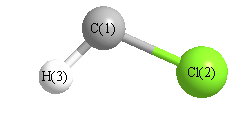Jump to
S2C1
Energy calculated at CCSD(T)=FULL/TZVP
| | hartrees |
|---|
| Energy at 0K | -498.176931 |
| Energy at 298.15K | -498.176791 |
| HF Energy | -497.836310 |
| Nuclear repulsion energy | 38.329916 |
The energy at 298.15K was derived from the energy at 0K
and an integrated heat capacity that used the calculated vibrational frequencies.
Geometric Data calculated at CCSD(T)=FULL/TZVP
Point Group is Cs
Cartesians (Å)
| Atom |
x (Å) |
y (Å) |
z (Å) |
|---|
| C1 |
0.045 |
1.207 |
0.000 |
| Cl2 |
0.045 |
-0.510 |
0.000 |
| H3 |
-1.042 |
1.432 |
0.000 |
Atom - Atom Distances (Å)
| |
C1 |
Cl2 |
H3 |
| C1 | | 1.7173 | 1.1106 |
Cl2 | 1.7173 | | 2.2262 | H3 | 1.1106 | 2.2262 | |
 More geometry information
More geometry information
Calculated Bond Angles
| atom1 |
atom2 |
atom3 |
angle |
|
atom1 |
atom2 |
atom3 |
angle |
| Cl2 |
C1 |
H3 |
101.701 |
|
Electronic energy levels
Charges, Dipole, Quadrupole and Polarizability
Jump to
S1C1
Energy calculated at CCSD(T)=FULL/TZVP
| | hartrees |
|---|
| Energy at 0K | -498.171561 |
| Energy at 298.15K | -498.171414 |
| HF Energy | -497.862802 |
| Nuclear repulsion energy | 38.598489 |
The energy at 298.15K was derived from the energy at 0K
and an integrated heat capacity that used the calculated vibrational frequencies.
Geometric Data calculated at CCSD(T)=FULL/TZVP
Point Group is Cs
Cartesians (Å)
| Atom |
x (Å) |
y (Å) |
z (Å) |
|---|
| C1 |
0.037 |
1.167 |
0.000 |
| Cl2 |
0.037 |
-0.518 |
0.000 |
| H3 |
-0.841 |
1.800 |
0.000 |
Atom - Atom Distances (Å)
| |
C1 |
Cl2 |
H3 |
| C1 | | 1.6849 | 1.0823 |
Cl2 | 1.6849 | | 2.4785 | H3 | 1.0823 | 2.4785 | |
 More geometry information
More geometry information
Calculated Bond Angles
| atom1 |
atom2 |
atom3 |
angle |
|
atom1 |
atom2 |
atom3 |
angle |
| Cl2 |
C1 |
H3 |
125.789 |
|
Electronic energy levels
Charges, Dipole, Quadrupole and Polarizability
